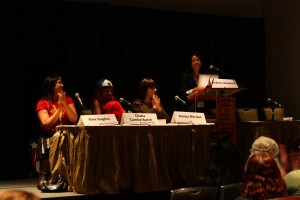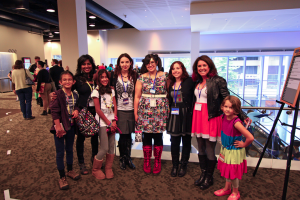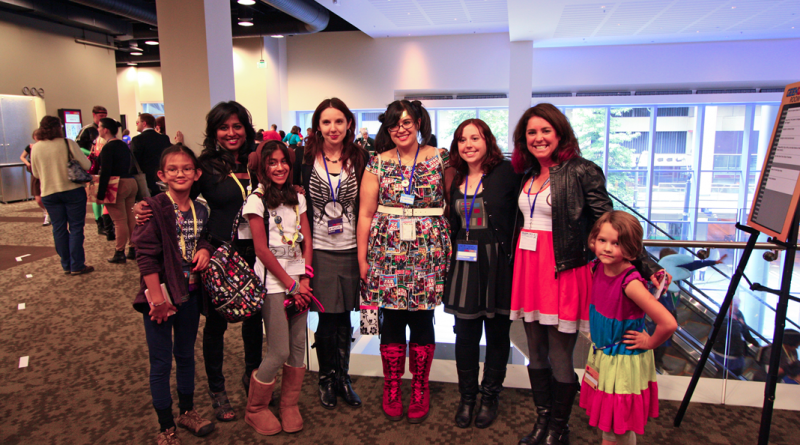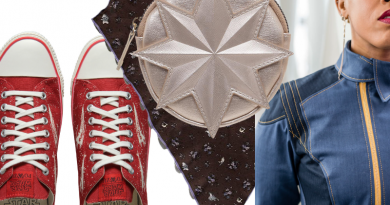GeekGirlCon 2013: Convention Recap
Previously I shared my recaps of the Star Wars panel and the Deconstructing the Mary Sue Myth panel at this year’s GeekGirlCon. Today I want to talk about some of the other highlights of this year’s convention in Seattle. I’ll start with the panels I attended, which inspired me to continue speaking out on fandom and franchise issues that matter to me.
Labor of Love: Why Women Make Transformative Works (Julian Bliss, Rachael Vaughn, Tegan Mulholland, and Torra Kimbul): The panel began by dispelling two myths: one, that fan works are “illegal” – when many of them may not constitute copyright infringement under “fair use” principles because they transformatively comment on the original source and do not undermine the commercial market for the original, for example – and two, that fan works are silly, not serious, or principally pornographic. The panelists then talked about why they enjoy creating fan works, which ranged from fanfiction and fan art to vidding and cosplay.
 The conversation then turned to some of the double standards faced by fan-work creators. In critical circles, art is acknowledged as a dialogue among individuals and over time, and the notion of the genius individual creator has been exposed as a myth. Nevertheless, in many discussions fan-work creators often are dismissed as being derivative or unoriginal in their work. The comparison was drawn to how women’s domestic labor traditionally has been devalued and invisibilized in society, just as women’s contributions to fandom often received dismissive treatment. Similarly, although women were significant figures in the creation of the art of vidding as far back as splicing VCR clips in the 1980s, a major museum hosted a prominent exhibit of a man’s work consisting of Superman art and the Three Doors Down song “Kryptonite” as though it were a creative innovation – and despite it being lower in quality to many fan vids based on the same concept. (Along similar lines, while Pacific Rim is lauded as an original story, Honest Trailers points out that the concept is essentially borrowed from several existing franchises.) When Amazon recently launched its Kindle Worlds program for publishing fanfiction in certain pre-approved fandoms, it contacted male authors and writers with male sounding names about publishing their stories, even though fanfiction is predominantly written by female authors. Even before attending this panel, I had been working on a post for FANgirl about the double standards used to dismiss fanfiction while lauding other unofficial and unapproved creative endeavors. I’m now more inspired to finish that post and share it.
The conversation then turned to some of the double standards faced by fan-work creators. In critical circles, art is acknowledged as a dialogue among individuals and over time, and the notion of the genius individual creator has been exposed as a myth. Nevertheless, in many discussions fan-work creators often are dismissed as being derivative or unoriginal in their work. The comparison was drawn to how women’s domestic labor traditionally has been devalued and invisibilized in society, just as women’s contributions to fandom often received dismissive treatment. Similarly, although women were significant figures in the creation of the art of vidding as far back as splicing VCR clips in the 1980s, a major museum hosted a prominent exhibit of a man’s work consisting of Superman art and the Three Doors Down song “Kryptonite” as though it were a creative innovation – and despite it being lower in quality to many fan vids based on the same concept. (Along similar lines, while Pacific Rim is lauded as an original story, Honest Trailers points out that the concept is essentially borrowed from several existing franchises.) When Amazon recently launched its Kindle Worlds program for publishing fanfiction in certain pre-approved fandoms, it contacted male authors and writers with male sounding names about publishing their stories, even though fanfiction is predominantly written by female authors. Even before attending this panel, I had been working on a post for FANgirl about the double standards used to dismiss fanfiction while lauding other unofficial and unapproved creative endeavors. I’m now more inspired to finish that post and share it.
Ultimately, though the panel was interesting, I felt it lacked cohesiveness and focus. The “Labor of Love” title resulted in some debate among the attendees and panelists. Digging deeper into the sociological reasons why women have been willing to create content for free and support fandoms solely for the love it – and the question of whether they should be doing so when men are getting paid to do the same work – would have kicked this panel up a notch.
The Psychology of Cosplay: Culture, Consent, and Misconceptions (Andrea Letamendi, Chaka Cumberbatch, Jessica Merizan, and Kimi Hughes): Drea is a Ph.D. psychologist conducting an academic study of cosplay, and three prominent cosplayers joined her to discuss the subject of cosplay and the results of her research. Drea began by sharing her definition of cosplay: a visible expression of fandom accompanied by a psychological transformation related to the character (or other aspect of fandom being cosplayed). The other panelists agreed that whether a person is cosplaying is in the mind of the cosplayer; no external barometer or objective standard determines what is or is not cosplay – which might run the gamut from superhero outfits and Renaissance Faire period attire to the infamous black-and-silver costumes of passionate Oakland Raiders football fans.
 Drea then shared some of the results of her research study, which involved responses from 966 cosplayers. They were 74% female, ranged in age from 13 to their 70s, and were overwhelmingly white. The other panelists agreed that women tend to predominate in cosplay circles, and that the underrepresentation of minority participants in the community is primarily attributable to the lack of minority characters in mediums like television, film, and comics – cosplayers generally seek to portray a character accurately, and so people who don’t see a lot of faces that look like them in the stories don’t have many characters to choose from if they want to cosplay. This lines up with another finding of Drea’s study, which is that the number one criteria for selecting a character to cosplay is the character’s personality, rather than the visual look of the costume or other factors. The fewer characters there are to choose from, the more likely it is that fans won’t find one whose personality connects with them. Likewise, even though many female fans might prefer to cosplay attire on the less revealing or sexualized side of the spectrum, the options available from the creation side often limit the choices available to a cosplayer who wants to be accurate to what’s on the screen or page. Hopefully artists and costume designers on creative teams will take note, and in the future will provide wider range of characters and clothing for cosplayers to recreate.
Drea then shared some of the results of her research study, which involved responses from 966 cosplayers. They were 74% female, ranged in age from 13 to their 70s, and were overwhelmingly white. The other panelists agreed that women tend to predominate in cosplay circles, and that the underrepresentation of minority participants in the community is primarily attributable to the lack of minority characters in mediums like television, film, and comics – cosplayers generally seek to portray a character accurately, and so people who don’t see a lot of faces that look like them in the stories don’t have many characters to choose from if they want to cosplay. This lines up with another finding of Drea’s study, which is that the number one criteria for selecting a character to cosplay is the character’s personality, rather than the visual look of the costume or other factors. The fewer characters there are to choose from, the more likely it is that fans won’t find one whose personality connects with them. Likewise, even though many female fans might prefer to cosplay attire on the less revealing or sexualized side of the spectrum, the options available from the creation side often limit the choices available to a cosplayer who wants to be accurate to what’s on the screen or page. Hopefully artists and costume designers on creative teams will take note, and in the future will provide wider range of characters and clothing for cosplayers to recreate.
Buffy the Vampire Slayer & Fan Phenomena (Amy Peloff, Clinton McClung, Jane Espenson, Jennifer K. Stuller, and JoJo Stiletto; moderated by Suzanne Scott): I recently read Jennifer Stuller’s wonderful analytical anthology, which shares its title with the panel. The discussion among the panelists was equally insightful, including these highlights:
- The panel began with a simple question: Why are we still talking about Buffy a decade after the show came to an end on television? The panelists emphasized the impact of the show and its characters on fans’ lives, the relatability of the storylines and characters to everyone, and that television hasn’t seen these kinds of characters since Buffy.
- Buffy’s explosive fandom growth coincided (1997-2003) with the rapid expansion of online fandoms of all kinds in the early days of internet communities, and the panel discussed whether the show would have been able to succeed in the same way if it had launched more recently. In some ways services like DVDs, Netflix, and Hulu have created binge consumption of series, but other factors like live-Tweeting and Facebook fan pages have shifted the fan experience back toward the communal experience of watching a show at the same time. JoJo wondered whether the rapid-reactions online to the early episode of Agents of S.H.I.E.L.D. indicates that some fans aren’t even willing to give a show an entire season, much less longer, to see if it can hit its stride. Jane agreed from the perspective of her current position writing for Once Upon a Time, noting that fans on Twitter often declare that they will no longer watch the show based on their certainty in their predictions of where a certain plotline or character is going – even though those predictions are often wrong.
- Just as show’s creators had mentioned at New York Comic Con, Jane remarked that the Once team encourages fans to tweet their fan art, and favorites are posted in the writer’s room. She also praised fanfiction as a form of expression of fans’ passion for a story, and declared herself a “huge supporter” of it. Writing Buffy scripts felt like writing fanfiction because she was so enthusiastic about the series as a fan herself.
- The panel also discussed topics including: Buffy’s influence on current television shows, especially ones with paranormal aspects; the relationship between Buffy, feminism, and the Twilight franchise; and the future of the Buffy franchise officially and in fandom.
Final Thoughts
Once again this year’s convention was a delight. The staff is friendly, the panels enjoyable and enlightening, and the venue is top-notch.
 Along the way I had a chance to meet some original Star Wars fans: women who were writing Star Trek fanfiction and moved over to the Star Wars fandom and created some of the earliest fanzines. Talking to them gave me further historical perspective on the role of women in the original success of the franchise. From the recent The Making of the Return of the Jedi, I learned a woman ran the fan club in the early 1980’s and responses to an early screening of Jedi resulted in feedback that the movie needed more women. Yet somehow over the years we shifted from a trilogy of movies with a passionate female fanbase to a predominant perception – including by Lucasfilm, its licensees, and the media – of Star Wars as a boys’ franchise. To this day, with the key production team members for Episode VII announced this past week, Star Wars is still very much a boys’ club on the storytelling side. The ironic twist is that in 1981 Pat Nussam wrote in the ALDERAAN: The Star Wars Letterzine about the lack of men in the Star Wars fandom media.
Along the way I had a chance to meet some original Star Wars fans: women who were writing Star Trek fanfiction and moved over to the Star Wars fandom and created some of the earliest fanzines. Talking to them gave me further historical perspective on the role of women in the original success of the franchise. From the recent The Making of the Return of the Jedi, I learned a woman ran the fan club in the early 1980’s and responses to an early screening of Jedi resulted in feedback that the movie needed more women. Yet somehow over the years we shifted from a trilogy of movies with a passionate female fanbase to a predominant perception – including by Lucasfilm, its licensees, and the media – of Star Wars as a boys’ franchise. To this day, with the key production team members for Episode VII announced this past week, Star Wars is still very much a boys’ club on the storytelling side. The ironic twist is that in 1981 Pat Nussam wrote in the ALDERAAN: The Star Wars Letterzine about the lack of men in the Star Wars fandom media.
Between GeekGirlCon and New York Comic Con I met women who are inspired by Star Wars to reproduce costumes and create all-new ones, to tell stories in prose, video, and audio, and to create art. That is not all that they do, though. They are ambassadors for the franchise as service volunteers, running fanzines, or writing about the franchise for fansites and media. And they will gladly share stories about their numerous collections of shirts, books, comics, cooking items, and action figures that capture their fannish zeal. Over thirty years later, here’s to hoping Star Wars really is more than just a boys’ franchise.
Tricia Barr took her understanding of brand management and marketing, mixed it with a love of genre storytelling, and added a dash of social media flare to create FANgirl Blog, where she discusses Star Wars, fandom, and strong female characters. She also writes about Star Wars for Random House’s science fiction and fantasy blog Suvudu.com and Star Wars Insider magazine and is a contributor for Her Universe’s Year of the Fangirl. Her FANgirl opinions can be heard each week on the podcast Assembly of Geeks.
Tricia is putting the finishing touches on her first novel, Wynde – a military science fiction with a fantastical twist that features heroines Vespa and Gemini. For excerpts and tales of her adventures in creating a fictional universe, hop over to TriciaBarr.com.
For updates on all things FANgirl follow @FANgirlcantina on Twitter or like FANgirl Zone on Facebook. At times she tries the Tumblr.
- Hyperspace Theories: Bad Luck Ghorman - June 2, 2025
- Hyperspace Theories: One Year Later as ANDOR Kicks Off Season Two - May 15, 2025
- REVIEW: Tales of the Underworld - May 4, 2025












Pingback:Ink-Stained Amazon » Blog Archive » Some thoughts on GeekGirlCon ’13 + A Post-Event Round-Up of Community Impressions